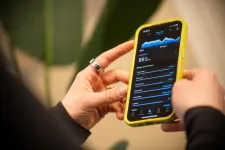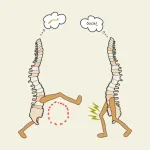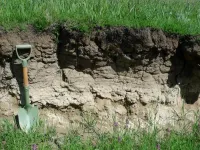(Press-News.org) What if changes in a person’s stress levels could be detected while they sleep using wearable devices? A new study by University of Vermont researchers published today in PLOS Digital Health is the first to find changes in perceived stress levels reflected in sleep data—an important step towards identifying biomarkers that may help flag individuals in need of support.
Given how critical sleep is to physical and mental health, the research team suspected signals might exist in sleep data, says Laura Bloomfield, a research assistant professor of mathematics and statistics and lead author of the study. “Changes in stress are visible.”
When parsing baseline sleep data, the researchers found “consistent associations” between people’s perceived stress scores and factors such as total sleep time, resting heart rate and heart rate variability, and respiratory rate. While it’s no surprise that most participants received less than the recommended 8 to 10 hours of sleep for young adults, the minutes do matter. For every additional hour of sleep recorded, the odds of someone reporting moderate-to-high stress decreased about 38 percent. Nightly resting heart rates offered more clues. For each additional beat per minute, the odds of experiencing stress increased by 3.6 percent.
Bloomfield is a principal investigator of the Lived Experience Measured Using Rings Study (LEMURS)—a longitudinal study started at UVM in 2022 that tracks hundreds of first- and second-year college students 24 hours a day using a wearable Oura ring biosensor and through surveys about their wellbeing. This is the first peer-reviewed paper from LEMURS and shows that data gleaned from wearables can reveal changes in people’s mental health status.
“The study showed that sleep measures from the Oura ring were predictive of participants’ perceived level of stress. If we are able to identify in real-time that someone is experiencing increased stress, there might be an opportunity to offer helpful interventions.,” Bloomfield explains. “There are a lot of ways to implement interventions, but the first step is understanding the connection between sleep measures and mental health measures.”
About LEMURS
The LEMURS project was conceived by Chris Danforth, professor of applied mathematics at UVM’s Vermont Complex Systems Center and fellow of the Gund Institute for Environment and Bloomfield, MD/Ph.D., to determine how wearable technologies could be used to improve young people’s health and well-being with personalized health feedback. LEMURS is supported by a grant from MassMutual.
College students, in general, don’t sleep enough, often feel stressed, and are at greater risk of experiencing mental health issues. The LEMURS research team will also evaluate the effectiveness of interventions such as exercise, excursions into nature, and group therapy—all interventions which have previously shown improvements in health and wellbeing—to understand which work best and how quickly scalable they are for large populations. But to do all of this requires identifying biometric data that provide the clearest signals for addressing changes in physical and mental health—a process that involves gathering and sifting through millions of hours of data each year.
LEMURS participants wear Oura rings that quietly collect measurements including temperature, heart rate, breathing rate, and nightly sleep duration as well as complete routine surveys to collect more subjective responses about potential stressors and their emotions. Location information is also used to calculate the exposure participants have to nature. All this data is then combed by LEMURS researchers like Mikaela Fudolig, research assistant professor of mathematics and statistics, who test specific relationships that could be used to develop health interventions. She co-authored the PLOS Digital Health paper and says there is power in the study’s numbers.
Initially, 600 first-year students aged 18 to 20 enrolled in LEMURS. A second cohort of first-year students was added in fall 2023 with a goal of following these individuals through college and far into the future.
“We have been tracking the same students for almost two years now, and there are very few studies that do that,” says Fudolig, research assistant professor of mathematics and statistics, who co-authored the PLOS Digital Health paper and says there is power in the study’s numbers. “We have several sources of data. Taking these all together—your ring data, your survey data, your nature-dose data, we also have blood work done—we will see a lot of different dimensions from these participants. So, combining them is, to me, the most exciting thing of it all.”
These potential predictors of stress led to a sleep analysis of LEMURS participants by Fudolig which detected two distinct heart rate curves, particularly among women. We find that those who reported an impairment in their daily life due to anxiety or depression had heart rates that dropped later in the night, she explains.
“A high burden of stress”
The COVID-19 pandemic worsened mental health problems for an already vulnerable population. In the decade before COVID, the Center for Disease Control and Prevention found the percentage of high school students nationwide experiencing persistent feelings of sadness or hopelessness jumped from 26.1 percent to 36.7 percent. The CDC’s 2021 Youth Risk Behavior Survey showed another jump—42 percent of students reported feeling persistently sad.
This is one reason Danforth and Bloomfield launched LEMURS in the first place.
“There is a high burden of stress in this population,” Bloomfield says, “College is seen as a very carefree period of time where you are coming into your own, but it’s also a period with a lot of transition and a lot of additional stressors. There needs to be better, accessible support systems for young adults during this time.
She wasn’t surprised to learn that perceived stress scores of LEMURS participants were high—64% of responses were considered moderate-to-highly stressed. These are personal assessments of how individuals feel about problems they encounter and their ability to manage them and responses vary depending on one’s life experiences, personality, support, and coping skills. Part of the challenge with interpreting stress signals using biometric data is figuring out when deviations from someone’s baseline are problematic and concerning, Bloomfield explains.
“This is a resilient population, they are young and healthy,” she continues. “But I think this study is bringing to light important issues facing this population. The ultimate goal with our research is that you can help support people in times of decreased mental health or physical health status.”
Additional UVM researchers involved in this study include Julia Kim, Jordan Llorin, Juniper Lovato, Matt Price, Taylor H. Ricketts, Peter Sheridan Dodds, Kathryn Stanton, and Christopher M. Danforth, working with Ellen McGinnis and Ryan McGinnis (Wake Forest University). This is the first peer-reviewed paper from UVM’s Lived Experience Measured Using Rings Study, a longitudinal investigation using wearable technologies to detect and incentivize positive changes in physical and mental health. The study is funded by a grant from MassMutual.
END
Scientists use wearable technology to detect stress levels during sleep
UVM study is the first to surface perceived stress using sleep data
2024-04-11
ELSE PRESS RELEASES FROM THIS DATE:
Beautiful nebula, violent history: Clash of stars solves stellar mystery
2024-04-11
When astronomers looked at a stellar pair at the heart of a stunning cloud of gas and dust, they were in for a surprise. Star pairs are typically very similar, like twins, but in HD 148937, one star appears younger and, unlike the other, is magnetic. New data from the European Southern Observatory (ESO) suggest there were originally three stars in the system, until two of them clashed and merged. This violent event created the surrounding cloud and forever altered the system’s fate.
“When doing background reading, ...
A magnetic massive star was produced by a stellar merger
2024-04-11
Shedding light on why some massive stars have magnetic fields even though these stars’ interiors layers don’t undergo convection, researchers report observational evidence that magnetic fields form in some such stars through stellar mergers. The magnetic fields of low-mass stars, like the Sun, are produced by a dynamo generated in the convective layers of the star’s interior. Massive stars – those 8 or more solar masses at formation – do not have the convective interiors required to sustain magnetic fields in ...
Thin oil films enable stable oil and water mixtures sans surfactant
2024-04-11
Thin oil films absorbed onto the surface of water droplets lead to anomalously stable, surfactant-free oil and water mixtures, according to a new study. The findings demonstrate a mechanism for stabilizing water droplets in a water-oil emulsification without the need for a surfactant, which could have important technological applications, including the creation of very pure and controlled materials. Oil and water cannot form homogenous mixtures. Instead, when combined, droplets of one fluid will disperse inside the other, forming ...
*FREE* Growing tribal clean energy in the US
2024-04-11
New US federal legislation sets aside nearly $14 billion for 574 federally recognized indigenous nations and villages, which can be used to support tribal climate responsiveness and energy sovereignty. In a Policy Forum, Kimberly Yazzie and colleagues present a roadmap for designing, implementing, and funding projects and people to accelerate the renewable energy transition while also benefiting the indigenous entities involved. According to the authors, this opportunity positions indigenous communities to develop their economies and energy projects ...
The nitroplast revealed: a nitrogen-fixing organelle in a marine alga
2024-04-11
A nitrogen-fixing bacterial endosymbiont of marine algae is evolving into a nitrogen-fixing organelle, or nitroplast, according to a new study, thereby expanding a function that was thought to be exclusively carried out by prokaryotic cells to eukaryotes. Eukaryotic cells are remarkably complex and contain various organelles, which are specialized structures within a living cell that have specific biological functions. Two organelles, mitochondria and chloroplasts, play a key role in energy metabolism and ...
First step to untangle DNA: supercoiled DNA captures gyrase like a lasso ropes cattle
2024-04-11
Picture in your mind a traditional “landline” telephone with a coiled cord connecting the handset to the phone. The coiled telephone cord and the DNA double helix that stores the genetic material in every cell in the body have one thing in common; they both supercoil, or coil about themselves, and tangle in ways that can be difficult to undo. In the case of DNA, if this overwinding is not dealt with, essential processes such as copying DNA and cell division grind to a halt. Fortunately, cells have an ingenious solution to carefully regulate DNA supercoiling.
In this study published in the journal Science, researchers ...
Brainless memory makes the spinal cord smarter than previously thought
2024-04-11
Aya Takeoka at the RIKEN Center for Brain Science (CBS) in Japan and colleagues have discovered the neural circuitry in the spinal cord that allows brain-independent motor learning. Published in Science on April 11, the study found two critical groups of spinal cord neurons, one necessary for new adaptive learning, and another for recalling adaptations once they have been learned. The findings could help scientists develop ways to assist motor recovery after spinal cord injury.
Scientists have known for some time that motor output from the spinal cord can be adjusted through practice ...
Study reveals giant store of global soil carbon
2024-04-11
Soil carbon usually refers only to the organic matter component of soils, known as soil organic carbon (SOC). However, soil carbon also has an inorganic component, known as soil inorganic carbon (SIC). Solid SIC, often calcium carbonate, tends to accumulate more in arid regions with infertile soils, which has led many to believe it is not important.
In a study published in Science, researchers led by Prof. HUANG Yuanyuan from the Institute of Geographic Sciences and Natural Resources Research of the Chinese Academy of Sciences (CAS) and Prof. ZHANG Ganlin from the Institute of Soil Science of CAS, together ...
Wired to learn and remember
2024-04-11
Leuven (Belgium), 11 April 2024 — The role of the spinal cord is often simplified to that of a simple relay station, carrying messages between the brain and the body. However, the spinal cord can actually learn and remember movements on its own. A team of researchers at the Leuven-based Neuro-Electronics Research Flanders (NERF) details how two different neuronal populations enable the spinal cord to adapt and recall learned behavior in a way that is completely independent of the brain. These remarkable ...
Penn Engineers recreate Star Trek’s Holodeck using ChatGPT and video game assets
2024-04-11
In Star Trek: The Next Generation, Captain Picard and the crew of the U.S.S. Enterprise leverage the holodeck, an empty room capable of generating 3D environments, to prepare for missions and to entertain themselves, simulating everything from lush jungles to the London of Sherlock Holmes. Deeply immersive and fully interactive, holodeck-created environments are infinitely customizable, using nothing but language: the crew has only to ask the computer to generate an environment, and that space appears in the holodeck.
Today, virtual interactive environments are also used to train robots prior to real-world deployment in a ...
LAST 30 PRESS RELEASES:
Practical education: Clinical scenario-based program development
The impact of family dynamics on eating behaviour – how going home for Christmas can change how you eat
Tracing the quick synthesis of an industrially important catalyst
New software sheds light on cancer’s hidden genetic networks
UT Health San Antonio awarded $3 million in CPRIT grants to bolster cancer research and prevention efforts in South Texas
Third symposium spotlights global challenge of new contaminants in China’s fight against pollution
From straw to soil harmony: International team reveals how biochar supercharges carbon-smart farming
Myeloma: How AI is redrawing the map of cancer care
Manhattan E. Charurat, Ph.D., MHS invested as the Homer and Martha Gudelsky Distinguished Professor in Medicine at the University of Maryland School of Medicine
Insilico Medicine’s Pharma.AI Q4 Winter Launch Recap: Revolutionizing drug discovery with cutting-edge AI innovations, accelerating the path to pharmaceutical superintelligence
Nanoplastics have diet-dependent impacts on digestive system health
Brain neuron death occurs throughout life and increases with age, a natural human protein drug may halt neuron death in Alzheimer’s disease
SPIE and CLP announce the recipients of the 2025 Advanced Photonics Young Innovator Award
Lessons from the Caldor Fire’s Christmas Valley ‘Miracle’
Ant societies rose by trading individual protection for collective power
Research reveals how ancient viral DNA shapes early embryonic development
A molecular gatekeeper that controls protein synthesis
New ‘cloaking device’ concept to shield sensitive tech from magnetic fields
Researchers show impact of mountain building and climate change on alpine biodiversity
Study models the transition from Neanderthals to modern humans in Europe
University of Phoenix College of Doctoral Studies releases white paper on AI-driven skilling to reduce burnout and restore worker autonomy
AIs fail at the game of visual “telephone”
The levers for a sustainable food system
Potential changes in US homelessness by ending federal support for housing first programs
Vulnerability of large language models to prompt injection when providing medical advice
Researchers develop new system for high-energy-density, long-life, multi-electron transfer bromine-based flow batteries
Ending federal support for housing first programs could increase U.S. homelessness by 5% in one year, new JAMA study finds
New research uncovers molecular ‘safety switch’ shielding cancers from immune attack
Bacteria resisting viral infection can still sink carbon to ocean floor
Younger biological age may increase depression risk in older women during COVID-19
[Press-News.org] Scientists use wearable technology to detect stress levels during sleepUVM study is the first to surface perceived stress using sleep data




